Related Research Articles

John I of Brabant, also called John the Victorious was Duke of Brabant (1267–1294), Lothier and Limburg (1288–1294). During the 13th century, John I was venerated as a folk hero. He has been painted as the perfect model of a brave, adventurous and chivalrous feudal prince.
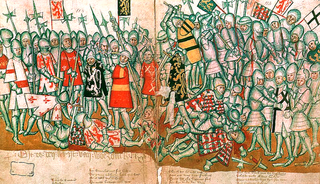
The Battle of Worringen was fought on 5 June 1288 near the town of Worringen, which is now the northernmost borough of Cologne. It was the decisive battle of the War of the Limburg Succession, fought for the possession of the Duchy of Limburg between on one side the Archbishop Siegfried II of Cologne and Count Henry VI of Luxembourg, and on the other side, Duke John I of Brabant.

Philip III was Duke of Burgundy from 1419 until his death. He was a member of a cadet line of the Valois dynasty, to which all 15th-century kings of France belonged. During his reign, the Burgundian State reached the apex of its prosperity and prestige, and became a leading centre of the arts.

Bouchout Castle is a castle in Meise, Flemish Brabant, Belgium. In the 12th century, this territory of the young Duchy of Brabant was strategically positioned between the County of Flanders and the Berthout family, lords of Grimbergen. Most likely, the first fortification was built by Wouter van Craaynem at the end of the Grimbergen Wars (1150–1170). Bouchout Castle is situated at an altitude of 32 metres (105 ft).

Beersel Castle is a medieval castle located in Beersel, Flemish Brabant, Belgium. Originating in 1300 under the auspices of the Duchy of Brabant, the water castle's present configuration dates to 1357. It was twice sacked and was subject to significant restorations in 1491 and 1617. Its present condition owes much to a major restoration in 1928–39. Built largely of brick, a rare material for such buildings at the time, around a circular enceinte, its major feature is its three large towers. Today, it is open to the public and is considered one of Belgium's best-preserved castles.

Affligem Abbey is a Benedictine abbey in the municipality of Affligem, Flemish Brabant, Belgium, 19 km (12 mi) to the north-west of Brussels. Dedicated in 1086, it was the most important monastery in the Duchy of Brabant and therefore often called Primaria Brabantiae.
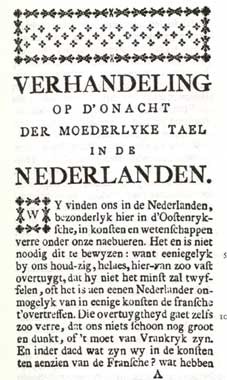
Jan-Baptist Chrysostomus Verlooy was a Brabantian jurist and politician from the Southern Netherlands.

Johan de Graeff, also Jan de Graeff - patrician of Amsterdam, Free Lord of Zuid-Polsbroek - was a member of the De Graeff - family from the Dutch Golden Age. His political Position was that of the Dutch States Party.

Ferdinand van Boisschot or de Boisschot (1570–1649), Baron of Zaventem, was a jurist and diplomat from the Low Countries who became chancellor of the Duchy of Brabant.
Guy I of Luxembourg-Ligny was Count of Saint-Pol (1360–1371) and Count of Ligny, Lord of Roussy and Beauvoir (1364–1371).

The Brabantsche Yeesten or Gestes de Brabant is a rhyming chronicle of some 46,000 verses written in the 14th and 15th centuries in the Middle Dutch language. It provides a history of the Duchy of Brabant, and the original five volumes were written by Jan van Boendale of Antwerp; his text was later extended to seven volumes.

Engelbert Maes (1545–1630), was chief-president of the Privy Council of the Habsburg Netherlands and Council of State from 1614 to 1630, making him a central figure in the government of the Habsburg Netherlands for sixteen years.

Jan van Boendale, formerly sometimes known as Jan De Klerk was a 14th-century secretary of the city of Antwerp and author of narrative and didactic verse. Two of his works, Brabantsche yeesten and Der leken spieghel, are listed in the Canon of Dutch Literature compiled by the Digital Library for Dutch Literature.
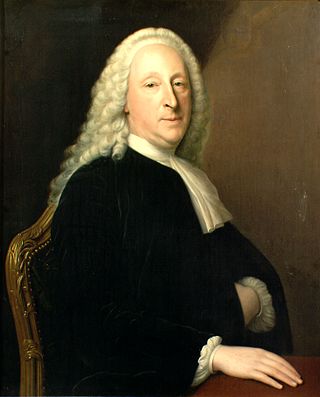
Wilhem (II) van Citters was a Dutch politician, who served as grand pensionary of Zeeland from 1760 to 1766.

Willem van Duvenvoorde or van Duvoorde (1290–1353), also known as Willem Snikkerieme, was a 14th-century nobleman and financier who served as a financial and political adviser to four successive counts and countesses of Hainaut and Holland.

Wein van Cotthem was a Brussels clerk, chaplain and chronicler.
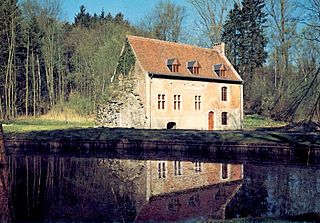
Dry Borren is a historic site in the Sonian Forest in the municiaplity Auderghem, Belgium. It was originally a hunting lodge of the dukes of Brabant, built on a site where three springs originated.
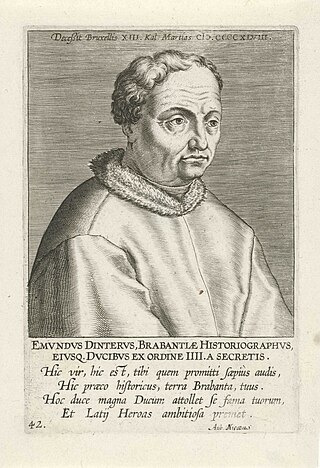
Emond Ambrosii de Dynter was a descendant of the noble family Van Dinther, originating from the village of the same name Dinther in Brabant. From 1412 he was secretary to the Brussels chancery of four successive dukes of Brabant and of Burgundy, namely: Anton of Burgundy, John IV of Brabant, Philip of Saint-Pol and Philip the Good.

The Van Cotthem family was an old patrician family of Brussels which exercised public functions in the capital of the Duchy of Brabant. Several of its members were aldermen of Brussels, and several were admitted to the Seven Noble Houses of Brussels. The family belonged to the House of Sweerts, the second of the Seven Noble Houses of Brussels.
References
- ↑ "A historian at work". www.mmdc.nl. Retrieved October 23, 2021.
- 1 2 3 "Petrus de Thimo". Encyclopedia of the Medieval Chronicle. Brill. Archived from the original on October 23, 2021. Retrieved October 23, 2021.
- ↑ Houthuys, Astrid (2009). Middeleeuws kladwerk: de autograaf van de Brabantsche yeesten, boek VI (vijftiende eeuw) (in Dutch). Verloeren. pp. 47–50.